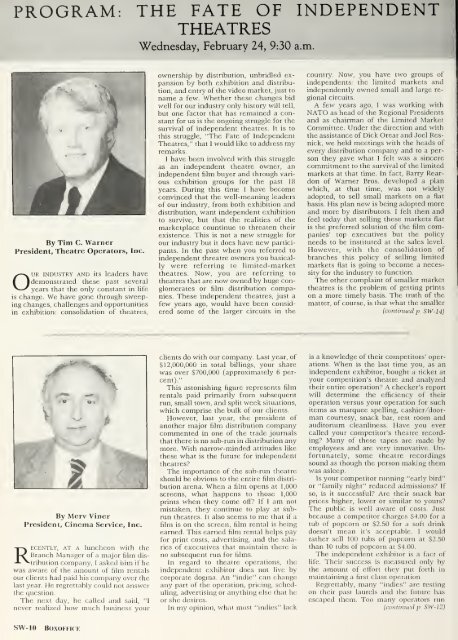Boxoffice-March.1988
You also want an ePaper? Increase the reach of your titles
YUMPU automatically turns print PDFs into web optimized ePapers that Google loves.
PROGRAM: THE FATE OF INDEPENDENT<br />
THEATRES<br />
Wednesday, February 24, 9:30 a.m.<br />
By Tim C. Warner<br />
President, Theatre Operators, Inc.<br />
OUR<br />
INDUSTRY AND its leaders have<br />
demonstrated these past several<br />
years that the only constant in life<br />
is change. We have gone through sweeping<br />
changes, challenges and opportunities<br />
in exhibition: consolidation of theatres,<br />
ownership by distribution, unbridled expansion<br />
by both exhibition and distribution,<br />
and entry of the video market, just to<br />
name a few. Whether these changes bid<br />
well for our industry only history will tell,<br />
but one factor that has remained a constant<br />
for us is the ongoing struggle for the<br />
survival of independent theatres. It is to<br />
this struggle, "The Fate of Independent<br />
Theatres," that I would like to address my<br />
remarks.<br />
I have been involved with this stRiggle<br />
as an independent theatre owner, an<br />
independent film buyer and through various<br />
exhibition groups for the past 18<br />
years. During this time I have become<br />
convinced that the well-meaning leaders<br />
of our industry, from both exhibition and<br />
distribution, want independent exhibition<br />
to survive, but that the realities of the<br />
marketplace countinue to threaten their<br />
existence. This is not a new struggle for<br />
our industry but it does have new participants.<br />
In the past when you referred to<br />
independent threatre owners you basically<br />
were referring to limited-market<br />
theatres. Now, you are referring to<br />
theatres that are now owned by huge conglomerates<br />
or film distribution companies.<br />
These independent theatres, just a<br />
few years ago, would have been considered<br />
some of the larger circuits in the<br />
country. Now, you have two groups of<br />
independents: the limited markets and<br />
independently owned small and large regional<br />
circuits.<br />
A few years ago, I was working with<br />
NATO as head of the Regional Presidents<br />
and as chairman of the Limited Market<br />
Committee. Under the direction and with<br />
the assistance of Dick Orear and Joel Resnick,<br />
we held meetings with the heads of<br />
every distribution company and to a person<br />
they gave what I felt was a sincere<br />
commitment to the survival of the limited<br />
markets at that time. In fact, Barry Reardon<br />
of Warner Bros, developed a plan<br />
which, at that time, was not widely<br />
adopted, to sell small markets on a flat<br />
basis. His plan now is being adopted more<br />
and more by distributors. I felt then and<br />
feel today that selling these markets flat<br />
is the preferred solution of the film companies'<br />
top executives but the policy<br />
needs to be instituted at the sales level.<br />
However, with the consolidation of<br />
branches this policy of selling limited<br />
markets flat is going to become a necessity<br />
for the industry to function.<br />
The other complaint of smaller market<br />
theatres is the problem of getting prints<br />
on a more timely basis. The truth of the<br />
matter, of course, is that what the smaller<br />
(continued p SW-H)<br />
By Merv Viner<br />
President, Cinema Service, Inc.<br />
RECENTLY,<br />
AT A luncheon with the<br />
Branch Manager of a major film distribution<br />
company, I asked him if he<br />
was aware of the amount of film rentals<br />
our clients had paid his company over the<br />
last year He regrettably could not answer<br />
the question.<br />
The next day, he called and said, "I<br />
never realized how much business your<br />
clients do with our company. Last year, of<br />
$12,000,000 in total billings, your share<br />
was over $700,000 (approximately 6 percent)."<br />
This astonishing figure represents film<br />
rentals paid primarily from subsequent<br />
run, small town, and split week situations,<br />
which comprise the bulk of our clients.<br />
However, last year, the president of<br />
another major film distribution company<br />
commented in one of the trade journals<br />
that there is no sub-run in distribution any<br />
more. With narrow-minded attitudes like<br />
these what is the future for independent<br />
theatres?<br />
The importance of the sub-run theatre<br />
should be obvious to the entire film distribution<br />
arena. When a film opens at 1,000<br />
screens, what happens to those 1,000<br />
prints when they come off? If I am not<br />
mistaken, they continue to play at subrun<br />
theatres. It also seems to me that if a<br />
film is on the screen, film rental is being<br />
earned. This earned film rental helps pay<br />
for print costs, advertising, and the salaries<br />
of executives that maintain there is<br />
no subsequent run for films.<br />
In regard to theatre operations, the<br />
independent exhibitor does not live by<br />
corporate dogma. An "indie" can change<br />
any part of the operation, pricing, scheduling,<br />
advertising or anything else that he<br />
or she desires.<br />
In my opinion, what most "indies" la

















